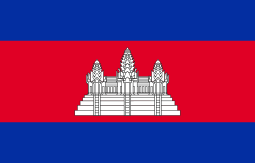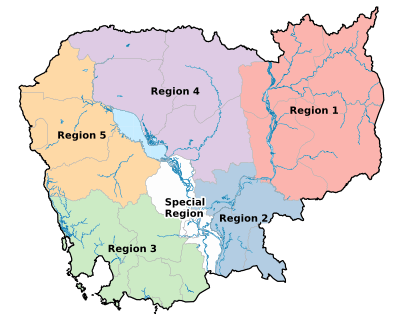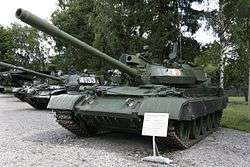Royal Cambodian Army
The Royal Cambodian Army (Khmer: កងទ័ពជើងគោក, Kangtorp Cheung Kork) is a part of the Royal Cambodian Armed Forces. It has ground forces which numbered 85,000 divided into eleven divisions of infantry, with integrated armour and artillery support. The Royal Army is under the jurisdiction of the Ministry of National Defence.
| Royal Cambodian Army | |
|---|---|
| កងទ័ពជើងគោក Kangtorp Cheung Kork | |
 Emblem of the Royal Cambodian Army | |
| Founded | 1953 |
| Country | |
| Allegiance | HM The King |
| Type | Army |
| Size | 85,000[1] |
| Part of | Royal Cambodian Armed Forces |
| Garrison/HQ | Phnom Penh |
| Motto(s) | Defending the Kingdom of Cambodia |
| Colours | Red, Blue |
| Anniversaries | 9 November 1953 |
| Engagements | First Indochina War Cambodian Civil War Cambodian–Vietnamese War 1997 clashes in Cambodia Cambodian–Thai border dispute |
| Commanders | |
| Current commander | General Hun Manet |
| Notable commanders | General Meas Sophea General Tea Banh General Srey Doek General Hun Manet General Hing Bun Hieng |
| Insignia | |
| Unit colour |  |
Military organisation

Under the current military plan and divisions, every military region has a full division size. Each division will be supplemented by a mobile reinforcement division in Phnom Penh. The country is divided into six, until recently five, military regions, each comprising three or four provinces. There are garrisons in major cities and major army bases.
General Hun Manet is the commander of the Royal Cambodian Army. He is also the Deputy Commander in Chief of the Royal Cambodian Armed Forces.
The forces are deployed as required across the country and in operations, with bases as follows:
- Region One: Headquarters are in Stung Treng and the region covers the provinces of Stung Treng, Ratanakiri and Mondulkiri.
- Region Two: Headquarters are in Kampong Cham and the region covers the provinces of Kampong Cham, Prey Veng, and Svay Rieng.
- Region Three: Headquarters are in Kampong Speu and the region covers the provinces of Kampong Speu, Takéo, Kampot, Preah Sihanouk, Koh Kong and Kep.
- Region Four: Headquarters are in Siem Reap and the region covers the provinces of Siem Reap, Oddar Meanchey, Preah Vihear, and Kampong Thom.
- Region Five: Headquarters are in Battambang and the region covers the provinces of Battambang, Pursat, Banteay Meanchey and Pailin.
- Special Region: Headquarters are in the capital, Phnom Penh and the region covers the provinces of Kampong Chhnang, Kandal and the greater municipality of Phnom Penh.
Every Military Region is under the command of a Major General, assisted by a Chief of staff with a rank of a Brigadier General. In every province, there is a military base called Military Operation Zone under the command of a Colonel.

Special Forces Airborne
Equipment
As of June 2010, it is assessed that 500 of the tanks are to be fully operational.
- 500+ tanks and an unknown number of light tanks.
- 300+ APC
- 600 Artillery
- 19 Helicopters

Operational art and tactical doctrine is still being defined as the process of reform continues. Ostensibly, the continuing military reorganisation will provide integrated armoured support for each of the regional infantry divisions. However, much of Cambodia's terrain does not lend itself to armoured operations and tanks are rendered unusable during the rainy season. All the OT-64 APCs have apparently gone to the Phnom Penh reserve force.
In the 1990s, to make the army more mobile and mechanised, there was a steady influx of new tanks, self-propelled artillery, armoured personnel carriers (APCs), and trucks. The ground forces seldom retire old models of weapons and tend to maintain a large equipment stock, keeping old models along with upgraded ones in the active force or in reserve. The army remains largely an infantry force, although a decade-long modernisation program has significantly improved the mobility and firepower of its active forces.
Equipment for the main force units was furnished by Vietnam, China, and by the Soviet Union. Armaments consisted of small arms of Soviet origin, including the AKM (updated version of the AK-47) assault rifle, RPD light machine gun, PKM general-purpose machine gun, RPG-2 82mm rocket-propelled grenade, RPG-7 85mm rocket-propelled grenade, Chinese Type 56 assault rifle, and various crew-served weapons, including towed medium howitzers, and air-defense weapons in several calibres. Tanks in the RCAF armoured battalions included the T-54/55, an old, but capable, main battle tank of Soviet origin; the obsolete PT-76/Type 63 light amphibious tank; and the Type-59, an older Chinese main battle tank, probably handed down from Vietnamese stocks. Multiple rocket launcher in main force included BM-14 and BM-21. Armored fighting vehicles in the main force inventory consisted of the Soviet BTR series of wheeled vehicles, and some ageing American equipment, such as: M106 armoured carriers and M113 armoured personnel carriers, either bequeathed by Vietnam or left behind from the days of the Khmer Republic.
Vehicles
Armoured fighting vehicles
| Name | Type | Quantity | Origin | Notes |
|---|---|---|---|---|
| T-55/T-55AM2BP | Main battle tank | 103[2] | ||
| Type-59D/Type69/79 | Main battle tank | 100[3] | ||
| Type 62/63 | Light Tank | 40[3] | 30 units Type 62 ordered in 1977 and another 10 units more Type 63 ordered for the next batch. | |
| PT-76 | 20[3] | 10 units ordered in 1983 from the Soviet Union and delivered in 1983 and another 10 units ordered in 1988 from the Soviet Union and delivered in 1989. | ||
| BMP-1 | Infantry fighting vehicle | 70[4] | ||
| BTR-60 PB | Armored Personnel Carrier | 160[5][3] | ||
| OT-64 SKOT | 60[6][3] | |||
| BTR-152 | unknown[7] | Possibly retired | ||
| BRDM-2 | Amphibious Armoured Scout Car | unknown[8] |
Transport
| Name | Type | Quantity | Origin | Notes |
|---|---|---|---|---|
| Dongfeng 6 | Militalry Transport | 150 | China | |
| Genpaw 4*2 | Militalry Transport | 290 | China | |
| BJ2022 | Light Militalry Transport | 75 | China | |
| Ural Trucks | Militalry Transport | 250 | Soviet Union |
Artillery
| Name | Type | Quantity | Origin | Notes |
|---|---|---|---|---|
| ZiS-3[4] | 76 mm anti-tank field gun | 50 | ||
| T-12[3] | ||||
| D-74[3] | 122 mm towed howitzer | |||
| M-30[3] | ||||
| D-30[4] | ||||
| M-46[3] | 130 mm towed field howitzer | 100 | ||
| Type 59-1[4] | 200 | |||
| Type 63[3] | 107 mm towed multiple rocket launcher | |||
| Type 81 SPRL[3] | 122 mm self-propelled multiple rocket launcher | 100 | ||
| BM-13/16[3] | 132 mm self-propelled multiple rocket launcher | |||
| BM-14[3] | 140 mm self-propelled multiple rocket launcher | 20 | ||
| BM-21 Grad[3] | 122 mm self-propelled multiple rocket launcher | 200[9] | ||
| RM-70 | 122 mm self-propelled multiple rocket launcher | 50[10] | ||
Anti-aircraft artillery
| Name | Type | Quantity | Origin | Notes |
|---|---|---|---|---|
| ZPU-2[4] | 14.5mm towed anti-aircraft gun | 100 | ||
| ZU-23-2 | 23 mm towed twin-barrel anti-aircraft gun | 100 | ||
| 61-K[4] | 37 mm towed anti-aircraft gun | 100 | ||
| AZP S-60[4] | 57mm towed anti-aircraft gun | 100 | ||
| KS-19[3] | 100 mm towed anti-aircraft gun | 50 | ||
| Bofors 40 mm[11] | anti-aircraft autocannon | 50 | ||
| KS-1 (missile)[12] | anti-aircraft missile | unknown | ||
Infantry weapons
| Small Arms | Type | Origin | Remark |
|---|---|---|---|
| Type 54[13] | Semi-automatic pistol | Standard issue | |
| QSZ-92 | |||
| Tokarev TT33[13] | |||
| Makarov PM | |||
| AKM[13] | Assault Rifle | ||
| AKMS[13] | |||
| Type 56[14] | |||
| Type 56-1[14] | |||
| Type 56-2[15] | Standard issue, Recently received and deployed to troops near the Cambodian-Thai border. | ||
| Type 81-1 | Recently received. | ||
| CQ 311 | Some are seen in use along with the M16A1 rifle. | ||
| CQ 5.56mm Type A | Chinese variant of the M4A1. Used by 911 Para-Commando Special Forces and Bodyguard Unit. | ||
| Pindad SS1-V1[16] | Used by 911 Para-Commando Special Forces, Military Police, and Bodyguard Unit. | ||
| M16A1[17] | Former FANK's main assault rifle. | ||
| Daewoo K1 | Used by 911 Para-Commando Special Forces. | ||
| Daewoo K2 | |||
| QBZ-97[18] | Bullpup Assault Rifle | Used by 911 Para-Commando Special Forces and Bodyguard Unit. Decommissioned and replaced by QBZ-97B. | |
| QBZ-97A[18] | Standard issue Used by 911 Para-Commando Special Forces. | ||
| QBZ-97B[18] | Standard issue Used by 911 Para-Commando Special Forces and Bodyguard Unit and Cambodian Royal Guards. | ||
| SKS[13][14] | Semi-Automatic Carbine | Used by Cambodian Royal Guards. Decommissioned and replaced by QBZ-97B. | |
| Type 56 Carbine[13][14] | Used by Cambodian Royal Guards and reserve training rifle. | ||
| Type 85 | Submachine Gun | Used by 911 Para-Commando Special Forces. | |
| Daewoo K7 | |||
| Mini Uzi | Used by the Bodyguard Unit. | ||
| HK MP5A4 | Used in small number by 911 Para-Commando Special Forces and by small number of Bodyguard Unit. | ||
| Type 79/85 | Sniper Rifle | Recently received. | |
| KBU-97A | |||
| RPK[14] | Light Machine Gun | ||
| RPD[13][14] | |||
| Type 56 LMG[13][14] | Standard issue | ||
| QBB-97 LSW | Used by 911 Para-Commando Special Forces. | ||
| PKM[14] | General-purpose machine gun | Also named as K57 | |
| Type 80[19] | Standard issue | ||
| DShK[13] | Heavy Machine Gun | Being replaced by W85 machine gun on ground troops, tripod mount. Remain in use on main battle tank. | |
| Type 54 HMG[13] | Being replaced by W85 machine gun on ground troops, tripod mount. Remain in use on main battle tank. | ||
| Type 77 | |||
| W85[19] | Standard issue | ||
| RPG-2[14] | Rocket-Propelled Grenade | ||
| RPG-7V2[13] | |||
| Type 56 RPG | Standard issue | ||
| Type 69 RPG | |||
| PF-89[15] | Light Anti-tank Rocket | Standard issue New infantry Anti-tank Rocket Launcher | |
| Armbrust[13] | Standard issue | ||
| SA-7 Grail[3] | Man-Portable Air-Defense Systems | ||
| HN-5[3] | |||
| FN-6[3][15] | |||
| FN-12/16[3][15] | Standard issue, Advance version of the FN-6. | ||
| M79[14] | Grenade Launcher | FANK's main grenade launcher. | |
| M203 | Attach on the M16A1 rifle, former FANK's grenade launcher. | ||
Peacekeeping Operations
The RCAF has sent RCAF personnel to various hotspots as part of the Kingdom of Cambodia's role as a member of the United Nations. Mostly engineers and logistical units, as well as Military Police and members of the paramilitary Armed Police have been sent to peacekeeping operations such as:[20]
Army ranks and insignia
| Equivalent NATO Code | OF-10 | OF-9 | OF-8 | OF-7 | OF-6 | OF-5 | OF-4 | OF-3 | OF-2 | OF-1 | OF(D) & Student officer | |||||||||||||||||||||||||
|---|---|---|---|---|---|---|---|---|---|---|---|---|---|---|---|---|---|---|---|---|---|---|---|---|---|---|---|---|---|---|---|---|---|---|---|---|
(Edit) |
 General of the Army |
 General |
 Lieutenant General |
 Major General |
 Brigadier General |
 Colonel |
 Lieutenant Colonel |
 Major |
 Captain |
 1st Lieutenant |
 2nd Lieutenant |
No equivalent | ||||||||||||||||||||||||
| នាយឧត្តមសេនីយ៍ផុតលេខ neay uttamseni photlekh |
នាយឧត្តមសេនីយ៍ neay uttamseni |
ឧត្តមសេនីយ៍ឯក uttamseniek |
ឧត្តមសេនីយ៍ទោ uttamsenito |
ឧត្តមសេនីយ៍ត្រី uttamsenit |
វរសេនីយ៍ឯក vorseniek |
វរសេនីយ៍ទោ vorsenito |
វរសេនីយ៍ត្រី vorsenit |
អនុសេនីយ៍ឯក anouseniek |
អនុសេនីយ៍ទោ anousenito |
អនុសេនីយ៍ត្រី anouseni trei | ||||||||||||||||||||||||||
| General of the Army | General | Lieutenant General | Major General | Brigadier General | Colonel | Lieutenant Colonel | Major | Captain | 1st Lieutenant | 2nd Lieutenant | ||||||||||||||||||||||||||
| Equivalent NATO code | OR-9 | OR-8 | OR-7 | OR-6 | OR-5 | OR-4 | OR-3 | OR-2 | OR-1 | |||||||||||||||||||||||||||
|---|---|---|---|---|---|---|---|---|---|---|---|---|---|---|---|---|---|---|---|---|---|---|---|---|---|---|---|---|---|---|---|---|---|---|---|---|
(Edit) |
 |
 |
 |
 |
 |
 |
 |
 |
 |
 | ||||||||||||||||||||||||||
| នាយចំណង់ | ព្រឹន្ទបាលឯក | ព្រឹន្ទបាលទោ | ពលបាលឯក | ពលបាលទោ | ពលបាលត្រី | នាយឯក | នាយទោ | ពលឯក | ពលទោ | |||||||||||||||||||||||||||
| Chief Warrant Officer | Warrant Officer | Command Sergeant Major | Master Sergeant | Staff Sergeant | Sergeant | Corporal | Lance corporal | Private 1st Class | Private | |||||||||||||||||||||||||||
See also
- Cambodian Civil War
- Khmer National Army
- Khmer National Armed Forces
- Royal Cambodian Armed Forces
- Royal Cambodian Air Force
- Royal Cambodian Navy
- Weapons of the Cambodian Civil War
References
- Anthony H. Cordesman; Robert Hammond (16 May 2011), THE MILITARY BALANCE IN ASIA: 1990-2011 (PDF), Center for Strategic and International Studies, p. 70, retrieved 27 June 2011
- Cambodian army armyrecognition.com
- SIPRI Trade Registers, Stockholm International Peace Research Institute, retrieved 27 June 2011
- "Cambodian Army Land Forces Equipment". ArmyRecognition.com. Retrieved 27 June 2011.
- https://www.armyrecognition.com/cambodia_uk/cambodia_cambodian_army_land_ground_forces_military_equipment_armoured_vehicle_pictures_information.html
- https://www.armyrecognition.com/cambodia_uk/cambodia_cambodian_army_land_ground_forces_military_equipment_armoured_vehicle_pictures_information.html
- https://www.armyrecognition.com/cambodia_uk/cambodia_cambodian_army_land_ground_forces_military_equipment_armoured_vehicle_pictures_information.html
- https://www.armyrecognition.com/cambodia_uk/cambodia_cambodian_army_land_ground_forces_military_equipment_armoured_vehicle_pictures_information.html
- armstrade.sipri.org/armstrade/page/trade_register.php
- https://www.armyrecognition.com/january_2014_global_defense_security_news_industry/army_of_cambodia_performs_first_live_fire_exercises_rm-70_122mm_mlrs_multiple_launch_rocket_1101146.html
- Bofors 40 mm#Users
- KS-1 (missile)
- Jones, Richard D. Jane's Infantry Weapons 2009/2010. Jane's Information Group; 35 edition (27 January 2009). ISBN 978-0-7106-2869-5.
- Christina Wille, How Many Weapons are there in Cambodia? (PDF), Small Arms Survey
- http://china-defense.blogspot.com/2009/10/cambodias-chinese-weapon-on-parade.html
- "Cikal Bakal Senapan Serbu Nasional". Alutsista Dalam Negeri (in Indonesian). Indonesia: 38–39.
- "Report: Profiling the Small Arms Industry - World Policy Institute - Research Project". World Policy Institute. November 2000. Retrieved 15 July 2010.
- "QBZ97自动步枪". Retrieved 16 January 2008.
- http://china-defense.blogspot.com/2011/05/mini-pla-in-making.html
- http://www.un.org.kh/index.php?option=com_content&view=article&id=203:moving-from-conflict-to-peacekeeping-42-cambodian-peacekeepers-sent-to-chad-and-central-african-republic-for-first-time&catid=43:latest-press-releases&Itemid=76
External links
| Wikimedia Commons has media related to Army of Cambodia. |
.svg.png)